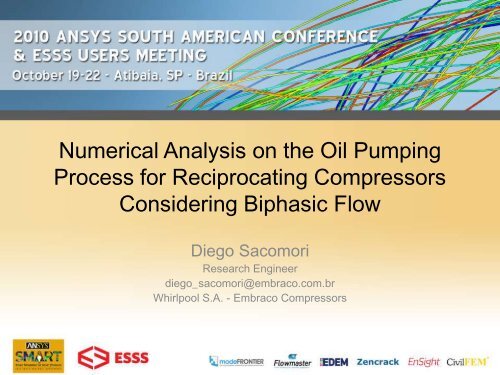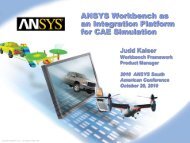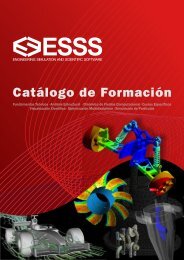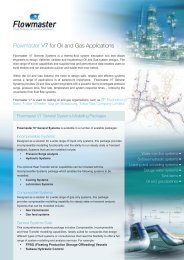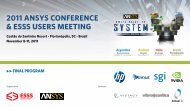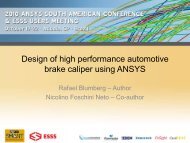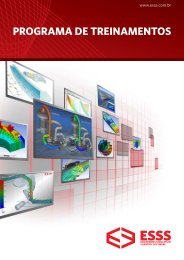Numerical Analysis on the Oil Pumping Process for ... - ESSS
Numerical Analysis on the Oil Pumping Process for ... - ESSS
Numerical Analysis on the Oil Pumping Process for ... - ESSS
Create successful ePaper yourself
Turn your PDF publications into a flip-book with our unique Google optimized e-Paper software.
Company ProfileItaly• Market and Technological Leader in Hermetic Compressors<strong>for</strong> Refrigerati<strong>on</strong>;• It offers complete cooling soluti<strong>on</strong>s in <strong>the</strong> development ofinnovative and high per<strong>for</strong>mance products <strong>for</strong> <strong>the</strong>commercial and household refrigerati<strong>on</strong> segments;• Almost 10 thousand employees worldwide;Missi<strong>on</strong>:"Provide innovative soluti<strong>on</strong>s<strong>for</strong> a better quality of life".
World PresenceUnited StatesItalyUSAItalySlovakiaChinaChinaMexicoBrazilBrazilCompressor PlantElectrical Comp<strong>on</strong>entsOfficeElectr<strong>on</strong>icsFoundry
Design to high efficiency compressorsImprovements <strong>on</strong> <strong>the</strong>:ManifoldMechanismsupportElectricmotorHighEfficiencyMechanicalPower LossesLubricati<strong>on</strong>Assure:Low noiseQuality and ReliabilityIt is very important to reliability and highefficiency in refrigerati<strong>on</strong> compressors.Low costs
<strong>Oil</strong> Supply System <strong>for</strong> Reciprocating Compressors• The lubricant oil is speed upby <strong>the</strong> centrifugal <strong>for</strong>ce until<strong>the</strong> sec<strong>on</strong>dary bearing, <strong>the</strong>n itis carried mechanically by <strong>the</strong>lubricati<strong>on</strong> groove.<strong>Oil</strong> hole - mainbearing<strong>Oil</strong> hole -sec<strong>on</strong>dary bearingOutlet <strong>for</strong> <strong>the</strong> pist<strong>on</strong><strong>Oil</strong> hole – eccentricbearingCrankcaseLubricati<strong>on</strong>groove... and about <strong>the</strong>pumping head?Crankshaft<strong>Oil</strong> pumpInlet – oil from case
<strong>Oil</strong> Supply System <strong>for</strong> Reciprocating Compressors• Modeling <strong>the</strong> simplified problem...dpprzdr pzrdzin rigid body moti<strong>on</strong>: p g a p e rzh0r1 p er p kz 2R1 r 2g2 R a za 0 0a 2 r r gk (a e2rr a e a k )zp z p1h122h2 2r r gz z r2g1 h2where,01R4g21
<strong>Oil</strong> Supply System <strong>for</strong> Reciprocating Compressors• and introducing a bottom hole... ur t ururrurur uzurz2ur p 1 u rrrrurr 12ru2r22 uzr2urr2u grQcP 2 ucdA A2r r 2rr c42 ru0c0dr• The open area of <strong>the</strong> pump’sorifice is unable to support <strong>the</strong>pumping pressure. So, <strong>the</strong> oilflows down through <strong>the</strong> hole.• “The pressure drop in <strong>the</strong> orificecan be determined by taking intoaccount of inflow and outflowthrough <strong>the</strong> hole”. (Itoh, 1992)
<strong>Oil</strong> Supply System <strong>for</strong> Reciprocating Compressors• The main variables at mechanical kit thatinfluences in <strong>the</strong> pumping head are:– Inlet and outlet diameter;– Blade presence– <strong>Oil</strong> viscosity;– Shaft speed;– Lubricati<strong>on</strong> groove and orifices– <strong>Oil</strong> pump imersi<strong>on</strong>;– Geometric deviati<strong>on</strong>sOperati<strong>on</strong>c<strong>on</strong>straintsPumpc<strong>on</strong>straintsAssemblyc<strong>on</strong>straintsEx.: c<strong>on</strong>centricity between pumpand rotati<strong>on</strong> axisShaftc<strong>on</strong>straints
CFD 3D Simulati<strong>on</strong> with ICEM/CFX‣ Meshing in <strong>the</strong> ICEM:• Easier to generate <strong>the</strong> interface domainsand c<strong>on</strong>trol <strong>the</strong> quality mesh.• Tetraedric mesh + prisms (near <strong>the</strong> wallto increase <strong>the</strong> resoluti<strong>on</strong>).
CFD 3D Simulati<strong>on</strong> with ICEM/CFX‣ Some opti<strong>on</strong>s to input <strong>for</strong> <strong>the</strong> CFX analysis:• Transient analysis• Biphasic flow (oil based water + air)• Time simulati<strong>on</strong> 2s (step 0.01s)• Buoyancy model• Homogeneous model <strong>for</strong> multiphase and heat transfer• Laminar flow• Imersi<strong>on</strong> 10mm• Angular speed 3000rpm
CFD 3D Simulati<strong>on</strong> with ICEM/CFX‣ and to raise <strong>the</strong> oil…1. To rotate <strong>the</strong> Pump’s walls• The geometry must be axisymmetric• It does not support eccentric pump2. To rotate <strong>the</strong> inside domain3. To de<strong>for</strong>me <strong>the</strong> mesh (not analyzed)
Outlet FlowCFD 3D Simulati<strong>on</strong> with ICEM/CFX‣ Mesh evaluati<strong>on</strong>:Number of elements
CFD 3D Simulati<strong>on</strong> with ICEM/CFX‣ Transient flow behaviorInitial timeTime step 5Time step 50Link to movieTime step 200
<str<strong>on</strong>g>Numerical</str<strong>on</strong>g> Results‣ Drives <strong>for</strong> <strong>the</strong> simulati<strong>on</strong>• Evaluate <strong>the</strong> oil flow sensivity relative to <strong>the</strong> pump variables:• Outlet diameter• Inlet diameter• Blade presence
Experimental Test• Bench Test:• The crankshaft rotati<strong>on</strong> isc<strong>on</strong>trolled by an inverter.• The oil flow is evaluatedby infrared sensors. Itcalculates <strong>the</strong> time to <strong>the</strong>oil speed up in a knownvolume.
Outlet Flow<str<strong>on</strong>g>Numerical</str<strong>on</strong>g> Results:‣ Blade evaluati<strong>on</strong>:1,2Superficialvelocity Z1,00,80,6it increases <strong>the</strong>momentum <strong>for</strong> <strong>the</strong> fluid.0,40,20,0Without BladeWith Blade0 50 100Time step150 200Superficialvelocity Z
Outlet Flow<str<strong>on</strong>g>Numerical</str<strong>on</strong>g> Results:‣ Outlet flow: 3 pump models:1,61,4This pump is able to providegood results, but is hard toassure <strong>the</strong> c<strong>on</strong>centricitybetween <strong>the</strong> bottom end and<strong>the</strong> rotati<strong>on</strong> axis in <strong>the</strong>manufacturing process.1,21,00,80,60,40,20,0REFERENCEPump RefPrototype C<strong>on</strong>centric PumpPrototype Eccentric Pump0 20 40 60 80 100 120 140 160 180 200Time step
Outlet FlowOutlet Flow<str<strong>on</strong>g>Numerical</str<strong>on</strong>g> Results:‣ Outlet diameter evaluati<strong>on</strong>:1,21,11,00,9Δ~10%Assemblyc<strong>on</strong>straint:to definetolerances<strong>for</strong> <strong>the</strong> outletdiameter0,80,70,610,50,40,30,2Outlet -0.4mmOutlet REF0,950,9ExperimentalresultsΔ~10%0,10,00 50 100 150 200 250 300Time stepOutlet +0.4mmAbove upper value (Outlet +0.4mm) <strong>the</strong> outflow isinsensitive to increase <strong>the</strong> outlet diameter.0,850,8Outlet REF Outlet - 0.4mmOutlet diameter (mm)
Outlet Flow<str<strong>on</strong>g>Numerical</str<strong>on</strong>g> Results:‣ Inlet diameter evaluati<strong>on</strong>:1,41,31,21,11,00,90,80,70,60,50,40,30,20,10,0Inlet -0.5mmInlet REFInlet +0.5mmInlet +1.0mmInlet +1.5mm0 50 100 150 200 250 300The relati<strong>on</strong> between <strong>the</strong> inletdiameter and <strong>the</strong> outlet flow is notlinear:- if <strong>the</strong> inlet is smaller, it c<strong>on</strong>stricts<strong>the</strong> flow;- if it is greater, <strong>the</strong> pumpingpressure drops due <strong>the</strong> open area.An optimum point must be find.Time step
Experimental Results:‣ Flow x Inlet x Outlet• The statistical analysis of<strong>the</strong> experimental resultsshows <strong>the</strong> similar directi<strong>on</strong>from numerical simulati<strong>on</strong>.
C<strong>on</strong>cluding remarks• The sensitivity analysis <strong>for</strong> <strong>the</strong> oil supply process has beenper<strong>for</strong>med.• The CFX/ICEM proven to be effective <strong>for</strong> this kind ofapplicati<strong>on</strong>. It is a powerful tool since it allows time andcosts reducti<strong>on</strong> looking <strong>for</strong> <strong>the</strong> geometric variables andtolerances in <strong>the</strong> prototype evaluati<strong>on</strong>.• The CFX still provide o<strong>the</strong>rs analysis <strong>on</strong> <strong>the</strong> flow behavior<strong>for</strong> this applicati<strong>on</strong> like: use of <strong>the</strong> turbulence models,comparis<strong>on</strong> between <strong>the</strong> different models to speed up <strong>the</strong>flow (domain moti<strong>on</strong>, rotati<strong>on</strong> wall, de<strong>for</strong>med mesh).
C<strong>on</strong>cluding remarks• The total time simulati<strong>on</strong> could be optimized if <strong>the</strong> meshingwas made in <strong>the</strong> Workbench.• Next steps:– Evaluate <strong>the</strong> oil flow c<strong>on</strong>sidering also <strong>the</strong> crankshaft’s c<strong>on</strong>straints.– Work to optimize <strong>the</strong> mesh (simulati<strong>on</strong> time).
Thank you <strong>for</strong> <strong>the</strong>attenti<strong>on</strong>!Diego Sacomoridiego_sacomori@embraco.com.br


